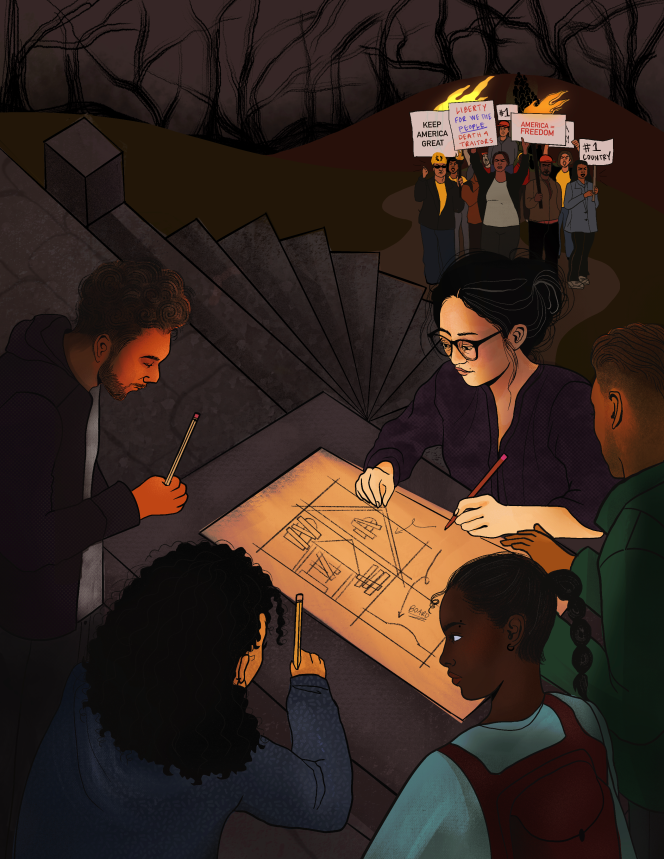Can you explain the concept of this artwork to us?
This issue of The Public Eye is centered around the multiracial Far Right and its relationship to White supremacy. The concept of this artwork comes from a metaphor used by Ash-Lee Woodard Henderson when describing the book Fire Dreams: Making Black Feminist Liberation in the South. She likened the book to a “blueprint” for creating a better world. I took that metaphor and combined it with an effort to illustrate the tension between two forces: the multiracial Far Right and the coalition working to block their efforts. I wanted to highlight this dichotomy in a way that told a story.
In the foreground, a group of “architects” gather around a table, putting forth a collective effort towards preventative measures—boarding up entry points to a house due to an impending storm. This storm forms behind a group of protesters, the multiracial Far Right, along with barren leafless trees which work to add to this atmosphere of desolation and dark, destructive energy. The spiral staircase not only represents this impending threat of the Far Right but also suggests a divide between these two worlds. The metaphor of this storm speaks to a real threat, and more literally represents conflicting ideologies. On one side, we have a coalition working methodically on a shared plan—a blueprint for resistance, united by a common goal to block the Far Right. In contrast, the far-right group embodies a form of collective rage and authoritarianism. The two groups are in opposition not just because of their surface-level differences—one is focused on building, the other on burning—but because of the fundamental nature of their goals. The coalition seeks to protect democratic values and promote a vision of society based on equity and inclusion. The far-right group, by contrast, stands for division, authoritarianism, and a rejection of inclusive progress. Their methods reflect this—while one group is building up, the other is symbolically tearing down.

What role do you see art playing in movements?
Because art is a visual medium, it has always had a way of transcending barriers, such as language or culture or class. It’s accessible, anyone can do it, and multiple interpretations can exist at once. Art, for me, has been a tool to interpret the world around me: not only what I see, but what I wish was real. In that same vein, it has a way of mirroring the struggles shared by many and helps give shape to things that are hard to say. Art gives a face to movements, challenges oppressive systems, and engages the public in a way that is unifying and helps people to feel seen.
What first drew you to art as a medium of resistance?
I’ve always thought it was easier to explain something to someone by getting it out on paper. Words can be hard and misinterpreted, but I don’t think art contains incorrect interpretations because the way one receives it is so personal. It inspires authentic emotional reactions, and I think that’s why it’s such a powerful tool in social movements. It’s also just accessible in the sense that marginalized voices can claim space in ways that are so often blocked or restricted.
Where do you draw inspiration from?
My art profile on instagram, breadgaze, showcases a lot of my inspiration. I’m mostly inspired by powerful female figures in my life—women who look like me and surround me, women who are radiant despite adversity. Living in New Orleans, it’s easy to find inspiration wherever you go. The city is colorful and embraced by people with colorful stories. More specific inspiration comes from my favorite designers and illustrators—Corita Kent and her use of color and hopeful phrases, and Amoako Boafo’s portraits.

